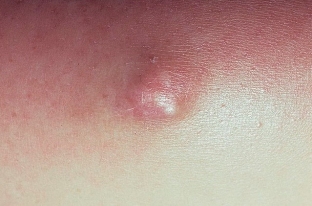In order for the human body to function properly, it is extremely important that the normal metabolic processes of all substances be preserved in it. Otherwise, various pathological processes may occur. One of these pathologies, resulting from a violation of mineral metabolism, is characterized by the deposition of calcium salts in soft tissues. In addition to the fact that the pathological process is an aesthetic defect, in severe cases it can significantly impair the patient's quality of life. Today on estet-portal.com read more about the main causes, characteristic symptoms and effective methods of treating skin calcification.
Clinical presentation and methods of treatment of skin calcification
Skin calcification – This is a pathological process characterized by the deposition of calcium salts in the soft tissues of the body. As a result – foci of calcification are visualized on the skin.
Skin calcification develops as a result of changes in systemic calcium metabolism, or as a local side effect of injuries, infections, tumors and inflammations.
In most cases, the affected lesions are an aesthetic defect that does not affect the functional state of the body, and does not cause pain. However, in severe cases, pathological lesions can cause pain and impair the patient's quality of life.
Skin calcification:
- main causes of skin calcification;
- features of the clinical picture of skin calcification;
- effective treatments for skin calcification.
The main causes of skin calcification
The causes of skin calcification can be divided into 4 large groups:
- dystrophic calcification develops with normal levels of calcium and phosphorus in the blood, as a result of mechanical, chemical, infectious or other influences. Presumably, in this case, the disease is provoked by cell death, as a result of which intracellular alkaline phosphatase and calcium are released, tissue acidity changes, and calcium salts precipitate out;
- Metastatic calcification occurs as a result of a violation of the metabolism of phosphorus and calcium in the body, and an increase in their concentration in the blood. The reason for this may be hyperparathyroidism, milk-alkaline syndrome, hypervitaminosis D, sarcoidosis and other pathologies;
- iatrogenic calcification is the result of medical procedures. It can be provoked by intravenous administration of large amounts of phosphorus and calcium, chemotherapy and long-term use of calcium-containing electrode pastes;
- idiopathic calcification develops in the patient's body in the absence of tissue damage or systemic metabolic defects.
Features of the clinical picture of skin calcification
The clinical picture of skin calcification may vary, depending on the underlying cause that provoked the development of the disease. A characteristic symptom of pathology is always the appearance on the skin of foci of calcification, which are dense papules, plaques or nodules of pale yellow color. The foci can be single or multiple, and they do not cause any discomfort. However, over time, they can become softer and ulcerate, while exuding a creamy white content that resembles chalk. If nodules form at the fingertips – the patient may feel some pain, if the place of their localization around the joints – mobility may be restricted.

Effective treatments for skin calcification
The therapeutic regimen for the treatment of skin calcification is selected in accordance with the cause that provoked the development of the disease. The most effective treatment for skin calcification is the use of medications:
- ointments with glucocorticoids;
- antacids with aluminum and magnesium for hyperphosphatemia;
- bisphosphonates;
- drugs that reduce the activity of parathyroid hormone;
- calcium channel blockers;
- sodium thiosulfate.
If patients experience pain, ulceration, functional impairment, and recurrent infections – they are treated surgically. However, it should be remembered that surgical trauma can stimulate calcification.
Skin calcification – it is a disease that is predominantly aesthetic in nature, but in severe cases it can significantly impair the patient's quality of life.
That is why it is very important to start effective treatment of the pathological process in a timely manner. estet-portal.com thanks you for your attention.
See also: "Calcium and Skin: How Calcium Levels Affect Skin"







Add a comment